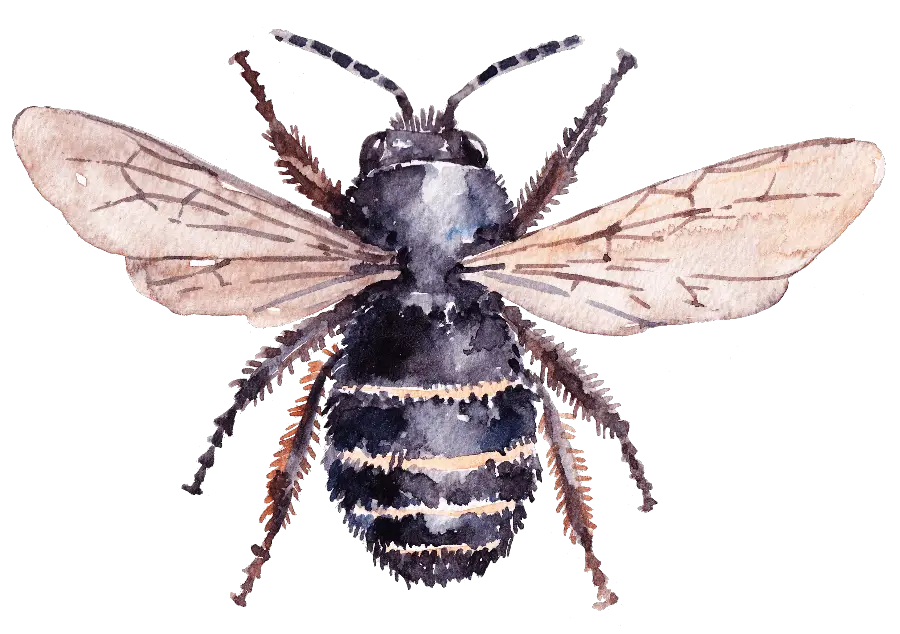Last updated on January 4th, 2024 at 02:50 pm
In the vast, buzzing realm of bees, the Anthophora plumipes, commonly known as the Hairy-Footed Flower Bee, is a standout character. With its unique appearance and intriguing habits, this bee is a testament to the wonders of the natural world. Let’s dive deep into the captivating life of the Hairy-Footed Flower Bee.
Appearance: A Furry Delight
The Hairy-Footed Flower Bee is a visual treat:
- Distinctive Fur: As the name suggests, this bee is adorned with a thick coat of hair, making it one of the furriest bees around.
- Sexual Dimorphism: Males and females have distinct appearances. Males are often light brown or ginger, while females are predominantly black.
- Size: They’re medium-sized bees, measuring around 10-13mm in length.
Habitat: From Gardens to Meadows
If you’re on the lookout for these furry acrobats, here’s where your search should lead:
- Geographical Spread: Predominantly found across Europe, with a significant presence in the UK.
- Preferred Habitats: They’re versatile in their choice of home, ranging from gardens and parks to meadows and open woodlands.
Behaviour: The Agile Foragers
The Hairy-Footed Flower Bee is known for its unique behaviours:
- Swift Flight: They’re known for their rapid, darting flight, making them a challenge (and a delight) to observe.
- Solitary Nature: Unlike some bees that live in colonies, these bees are solitary. Each female creates her own nest, often in the ground or in mortar joints of old walls.
Diet: A Floral Buffet
What tantalizes the taste buds of the Hairy-Footed Flower Bee?
- Nectar and Pollen: Like most bees, they feed on nectar and pollen. They have a particular fondness for lungworts, but they’re also known to visit a variety of other flowers.
- Vital Pollinators: Their diverse diet and foraging habits make them essential pollinators for many plants, ensuring biodiversity and the health of various ecosystems.
When and Where to Spot Them
For those eager to witness these bees in action:
- Time of Year: They’re early risers in the bee world, making their appearance from March to June.
- Time of Day: Daylight hours, especially during warm, sunny spells, are when they’re most active.
- Location: Gardens rich in lungwort plants are a magnet for these bees. However, meadows and woodlands can also offer sightings.
| Best Time to Spot | Location | Activity Level |
|---|---|---|
| Morning | Gardens | High |
| Midday | Meadows | Moderate |
| Early Evening | Woodlands | Moderate |
Male vs. Female Hairy-Footed Flower Bees: Spotting the Differences
The Hairy-Footed Flower Bee is a fascinating species with distinct differences between males and females. Understanding these differences can enhance our appreciation of these bees and make identifying them in the wild a delightful experience. Let’s delve into the key distinctions between male and female Hairy-Footed Flower Bees.
1. Appearance: Coloration
- Males: They often sport a light brown or ginger hue, giving them a somewhat brighter appearance. This colouration can sometimes make them resemble small, fast-flying bumblebees.
- Females: Predominantly black, females have a more uniform and darker appearance compared to their male counterparts.
2. Size
While both males and females are medium-sized bees, there can be subtle size differences. Typically, females might be slightly larger and more robust than males, but this can vary based on individual bees and environmental factors.
3. Behavior
- Males: They are known for their swift, darting flight patterns. During the mating season, male bees can be seen patrolling flowers in search of females. They’re also known to be more aggressive in defending their territory.
- Females: Females are diligent foragers, often seen collecting nectar and pollen to provision their nests. They’re also responsible for nest-building, typically creating burrows in the ground or in mortar joints of old walls.
4. Facial Hair
One of the more subtle differences is the presence of facial hair. Males tend to have longer, more conspicuous facial hair, which can sometimes give them a “moustached” appearance. This feature can be a bit challenging to spot unless you’re observing the bee up close.
5. Lifespan
In general, female bees tend to have a longer lifespan compared to males. While males primarily focus on mating and might live for a few weeks to a couple of months, females have the added responsibility of foraging and nest-building, extending their lives for several months.
Why They Matter
The Hairy-Footed Flower Bee, like all its buzzing counterparts, plays a pivotal role in our ecosystem:
- Pollination Pros: Their foraging habits ensure the pollination of a range of plants, contributing to biodiversity.
- Ecosystem Indicators: Their presence can be a sign of a healthy habitat. Conversely, a decline in their numbers might signal environmental challenges that need attention.
Conclusion
Identifying the gender of the Hairy-Footed Flower Bee can be a rewarding experience for nature enthusiasts. By understanding the differences between males and females, observers can gain deeper insights into the life cycle, behaviour, and roles of these bees in the ecosystem.
Whether you’re a casual observer or an avid bee enthusiast, the next time you spot a Hairy-Footed Flower Bee, take a moment to appreciate its unique characteristics and its contribution to the vibrant tapestry of nature.
The Hairy-Footed Flower Bee is more than just another member of the bee family. It’s a symbol of the intricate dance of nature, where every creature, no matter how small, has a role to play.
As we wander through gardens or explore the countryside, let’s take a moment to appreciate these furry wonders. And remember, every bee has a tale, a purpose, and a beauty all its own.
For a deeper dive into the world of bees and to help identify the myriad species that grace our planet, explore our comprehensive Bee ID page. Together, let’s celebrate and champion the buzzing wonders that make our world a more vibrant and interconnected place.





